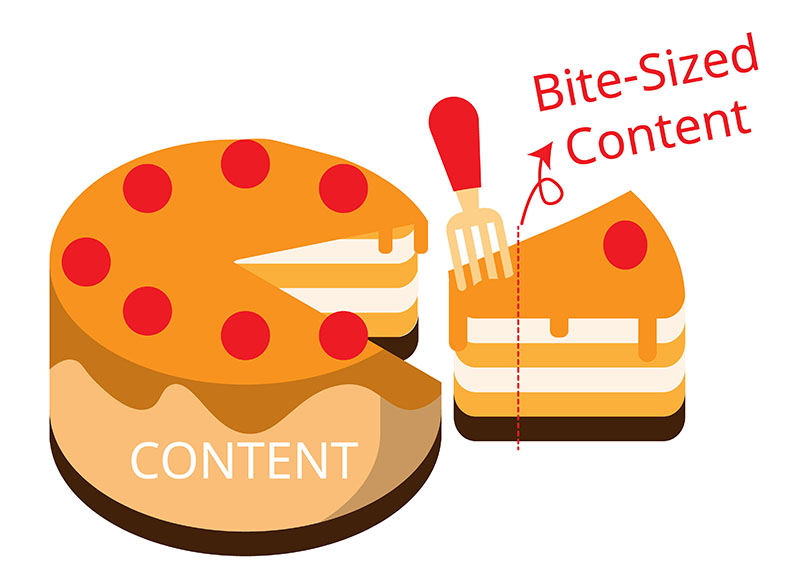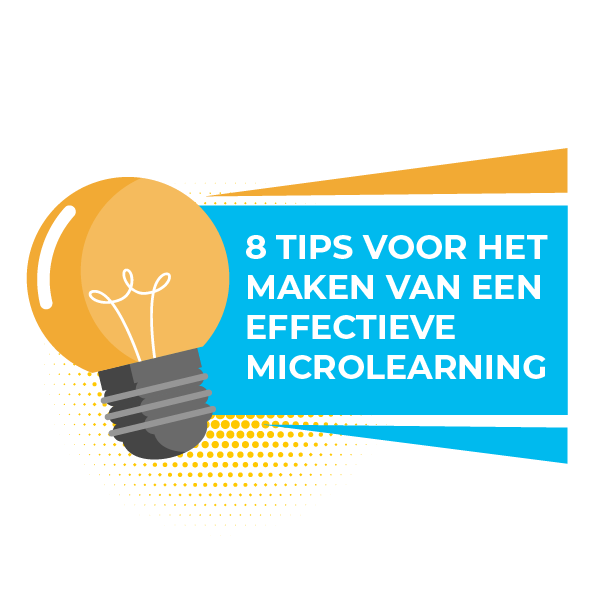Microlearnings worden steeds populairder. Terecht want deze mini-elearnings zijn zeer effectief om snel en praktisch te leren. Maar hoe maak je een effectieve microlearning? Waar moet je op letten? In dit artikel vertellen we je er meer over.
Voordat we ingaan op het maken van een effectieve microlearning staan we even stil bij de kracht en de voordelen van microlearning.
De kracht van microlearning
Microlearning is een manier van kennis overdragen waarbij informatie in kleine, hapklare stukjes (learning bites) van een paar minuten wordt aangeboden. Door het opdelen van informatie in mini-elearnings, concentreert de medewerker zich op één concept of vaardigheid tegelijk en is de informatie beter te begrijpen en te verwerken. Dit is vooral handig voor werknemers die weinig tijd hebben om te leren, maar wel snel nieuwe informatie moeten opnemen om hun werk goed te kunnen doen.
Dat is precies waar de kracht van microlearning ligt: in korte tijd zet je kennis en vaardigheden over een afgebakend onderwerp om zet in kennis. Geen wonder dat steeds meer bedrijven microlearning inzetten om medewerkers snel en effectief te trainen.
De voordelen van microlearning op een rijtje
1. Efficiëntie
Door informatie aan te bieden in kleine, hapklare brokjes van een paar minuten kan je je concentreren op een specifiek onderwerp zonder grote hoeveelheden tijd te investeren. Het past goed in drukke schema’s en kan gemakkelijk worden geïntegreerd in het dagelijkse werk.
2. Kennis blijft beter hangen
Onderzoek suggereert dat informatie beter wordt onthouden wanneer deze wordt gepresenteerd in kleinere, gerichte stukjes. Wanneer je de informatie regelmatig herhaald zorg je bovendien voor een betere opname en retentie van kennis.
3. Toegankelijkheid en gemak
Door microlearnings te delen via SMS, e-mail of QR-code, kunnen medewerkers de lesstof eenvoudig openen op smartphone, tablet of computer. Op het moment dat het uitkomt, waar ze ook zijn. Dit betekent dat ze in een eigen tempo en op eigen voorwaarden kunnen leren. Er zijn geen beperkingen meer door tijd of locatie. Microlearning maakt leren laagdrempelig.
4. Focus op specifieke vaardigheden en prestatieverbetering
Microlearning is bijzonder effectief als het gaat om het ontwikkelen en verbeteren van specifieke vaardigheden. Door complexe onderwerpen op te splitsen in kleinere componenten blijft de concentratieboog hoog. Dit maakt het leren eenvoudiger.
5. Praktisch en gericht op de werkvloer
Microlearning is zeer geschikt voor een praktische toepassing van kennis op de werkvloer. Het biedt werknemers specifieke informatie die direct kan worden toegepast in hun dagelijkse werkzaamheden. Hierdoor wordt de leerervaring relevanter en waardevoller.
Hoe maak je een effectieve microlearning?
Natuurlijk wil je het maximale uit je microlearning halen. Daarom is het belangrijk om beknopte en gerichte informatie te bieden die de leerdoelen ondersteunt. Hieronder vind je 8 tips hoe je een effectieve microlearning maakt:
1. Houd het eenvoudig en beknopt
Zorg dat de informatie die je opneemt in de microlearning kort en to-the-point is. Hier zijn een paar dingen om op te letten:
- Bedenk welke belangrijke informatie écht nodig is om het doel van het leren te bereiken.
- Gebruik simpele taal zonder poespas om ingewikkelde dingen uit te leggen.
- Hak de inhoud in kleine stukjes, zodat het makkelijker te begrijpen is.
- Maak gebruik van opsommingstekens, nummers, of leuke plaatjes om alles netjes te ordenen.
2. Het oog wil ook wat
Voor een effectieve microlearning is mooi beeldmateriaal belangrijk. Dit houdt het boeiend, stimuleert de betrokkenheid en helpt om de leerervaring te versterken. Hier zijn een paar tips:
- Gebruik afbeeldingen, infographics, of diagrammen in om informatie visueel te maken.
- Speel leuke video’s af om moeilijke processen of dingen te demonstreren.
- Gebruik kleur, verschillende lettertypes, en mooie layouts
- Animaties kunnen ook helpen om dingen stap voor stap uit te leggen.
3. Zorg voor mobiele toegankelijkheid
Zorg ervoor dat je microlearnings toegankelijk zijn op mobiele apparaten. Zo kan iedereen leren waar en wanneer ze maar willen.
4. Bied regelmatige herhaling aan
Herhaal de lesstof regelmatig. Door belangrijke concepten en informatie opnieuw te benadrukken, versterk je de kennisretentie en verhoog je de kans op toepassing in de praktijk.
5. Maak het interactief!
Interactieve elementen zoals vragen en simulaties betrekt mensen actief bij het leerproces. Voeg oefeningen, vragen, quizzes of casestudies toe. Zo leer je niet alleen, maar je ervaart het ook. Dit resulteert in betere leerresultaten en een verbeterde prestatie op de werkvloer.
6. Houd de timing in de gaten
Zorg ervoor dat je microlearnings zo zijn ontworpen dat ze in korte tijd kunnen worden voltooid. Wanneer ze slechts een paar minuten duren, zijn ze gemakkelijk in te passen, ook in een druk schema.
7. Pas aan op basis van feedback
Luister naar de feedback en pas je microlearnings aan op basis van behoeften en suggesties. Niet alleen toon je hiermee betrokkenheid, ook help je om voortdurend te verbeteren.
8. Evalueer de impact
Meet de impact van je microlearning-programma. Analyseer leerresultaten, prestatieverbeteringen en gedragsveranderingen om de effectiviteit ervan te beoordelen. Dit helpt je om de waarde van microlearning te demonstreren.
Effectieve microlearnings maken met LesLinq
LesLinq is dé microlearning oplossing die leren laagdrempelig en leuk maakt! De HTML5 authoring tool biedt enorm veel mogelijkheden om visueel aantrekkelijke, interactieve microlearnings te maken.
Door het gebruik van afbeeldingen, video, multiple choice vragen en animaties wordt leren leuker en boeiender. Dit helpt om de aandacht van de werknemer vast te houden en de informatie beter te laten beklijven.
LesLinq verstuurt de interactieve microlearnings via SMS, e-mail of QR-code naar de door jou ingevoerde gebruikers. Dit werkt met een weblink, je hoeft geen app te installeren. Het LMS dashboard van LesLinq geeft vervolgens controle en inzicht. Hier vind je de gegevens die je nodig hebt om de voortgang te controleren en je microlearnings te beheren en bij te sturen.
Doe de microlearning over het maken van een effectieve microlearning:
Klik in de afbeelding voor interactie (of open de inhoud in een nieuw browser venster)
Meer weten over het maken van microlearnings?
Wil je hier meer over weten? Bel Chris Hof op 0682 077 845 of stuur ons een e-mail. Meer van onze nieuwe oplossing zien? Plan een afspraak in voor een demo.
Hulp nodig bij het maken van microlearnings?
heb je wel de ideeën, maar niet de capaciteit om microlearnings te maken? Ook daarmee helpen we je graag. Neem contact met ons op voor de mogelijkheden.


